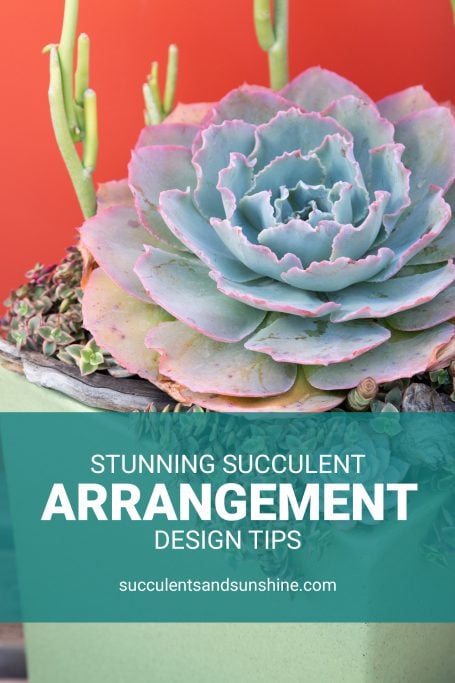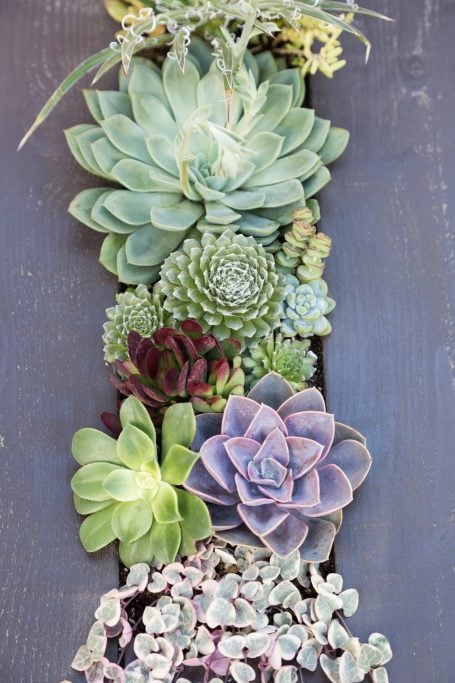Succulents are already stunning, so you don’t need to do much to make a great arrangement with them. Follow these tips to make your display truly remarkable!
When you buy something through our links on this website, we may get a commission but you will not pay any more. This commission helps us to provide you with free content.
In recent years, I have had the pleasure of crafting a variety of lovely succulent arrangements for myself, my ebooks, the Idiot’s Guide, and my friends and family. Additionally, I have had the opportunity to collaborate with talented succulent artists and document their gorgeous arrangements through photography.
Each of these designers has their own distinct style and approach, yet each arrangement looks like a masterpiece!
In this article, I have provided links to purchase the succulents that I have referenced in the design sections. As it can be difficult to find colorful succulents in your local area, the links I have included can assist you in finding the plants that you are searching for.
Table of Contents
Consider Colors
I’m always drawn to succulent arrangements that play off of different hues because of my background in art. It’s so fun to mix and match the different colors of succulents available, from bright pinks to deep blues. This way, I can create unique and eye-catching designs with a range of colors that span the entire rainbow.
Some succulents are limited to a single hue, typically green, but may possess a range of tints and tones of that color.
When putting together a monochromatic display, varying shapes and textures can make it more appealing. Have a look at these succulents that could give your monochromatic setup an eye-catching look.
For succulents, you can opt for groupings of analogous colors, which are adjacent on the color wheel. A specific example of this would be green, blue, and purple; or orange, yellow, and green.
I usually go for arrangements featuring greens, blues, and purples, but incorporating reds, oranges, and yellows can really make a statement and draw attention!
My favorite color combinations are based on complementary colors–hues that are opposite one another on the color wheel, such as red and green, blue and orange, yellow and purple.
My favorite succulent color combination is blue and orange, which is likely due to the rarity of plants in these colors and the vibrancy of the hues. Nonetheless, this red and green arrangement is equally vibrant and exciting!
You can get more insights from the video below regarding these tips.
Thriller, Filler, Spiller
It’s so straightforward, and it consistently produces excellent results.
A “thriller” succulent is a plant that stands out from the rest of the arrangement, either with its size, height, spiky shape, or a unique look that catches the eye. It should be the focal point of the design, making it the first thing people notice.
The main part of the arrangement should consist of “filler” succulents, which don’t have to be boring or dull! To add some variety, select succulents that complement your “thriller” succulents and provide visual interest in terms of color or texture. You can also use a variety of succulent types to add even more interest.
Succulents that ‘spill’ out of their pots are usually trailing plants such as ‘String of Pearls’, ‘String of Bananas’ or ‘String of Hearts’. These can also be plants like Sedum “Burrito” which will eventually spill out of the pot as they get longer.
No matter what type of container you select, ensure that it has enough of an edge to keep the soil and other components inside your pot. This can significantly extend the life of your floral arrangement.
Watch the video below to observe the steps I take to construct a sizable succulent planter box.
Consider Light Needs
Putting together an interesting design for a succulent arrangement can be exciting, but it’s important to keep in mind the amount of light each type of succulent needs. It’s commonly assumed that all indoor succulents require a lot of sunlight, but this isn’t actually the case; different species of succulents have different requirements for light exposure.
An example of contrasting plants is Sansevierias and Sedum nussbaumerianum. Sansevierias prefer low lighting and not full sun, while Sedum nussbaumerianum needs full sun exposure in order to keep its vibrant color and neat form.
It is essential to group succulents with similar lighting requirements together in your arrangement.
A comprehensive list of succulents that prefer full sun, partial shade, or low light could easily take up a book or website! To determine the lighting needs of your succulents, you can use resources such as World of Succulents and San Marcos Growers to look up the specific requirements of the plants you own.
A Google search for the succulent’s name can provide more information about the light requirements for its care.
When planting succulents outside, it’s necessary to select varieties that can tolerate the amount of sunlight they will be exposed to in your garden. Some succulents require full sun, while others need shade to thrive.
Grouping succulents that require similar amounts of light will guarantee that your entire display (or flower bed) will remain attractive for many years to come.
Leaf Thickness and Watering Needs
It is equally important to group together plants with the same watering requirements when creating your plant arrangement.
The simplest way to determine a plant’s water requirements at a glance is to observe the thickness of its leaves. If you are unsure, the best strategy is to identify the succulent in question and research its particular watering needs on World of Succulents or San Marcos Growers, or simply do a basic Google search.
No matter the approach – whether you’re sticking to a particular technique, guideline or tip, or you take a freestyle approach – succulents are a blast to pair. As long as the plants have similar light and watering requirements, and you use well-draining soil and proper watering methods, you really can’t go wrong when combining succulents.
If you’re looking for more advice and ideas on succulents, get a copy of my book, Idiot’s Guides: Succulents.
If you would like to view a video of these tips, you can see it here:
I recently had the pleasure of meeting the family behind Redeeming Eden and seeing some of the stunning succulent arrangements they had crafted. I was lucky enough to take pictures of several of these gorgeous table displays that they had made.
I was instantly captivated by the table in their garden. This has been something I have wanted to do for some time, and seeing theirs has given me the motivation to try and replicate it. They made the table themselves and used Olympic Maximum Waterproofing Sealant to protect it from any water damage. I’m really impressed with how it turned out!
If you want to create something similar, make sure to include drainage holes to ensure your succulents don’t become waterlogged. It’s an excellent way to make a statement, and the table is the ideal size – not too big, not too small. Put this next to your outdoor seating and it will be both functional and aesthetically pleasing!
Do you feel motivated to create something amazing with succulents?
FAQ
How do you make beautiful succulent arrangements?
How do you stimulate succulents to grow?
Suggestions:
– Allow them some space. …
– Give them some shelter. …
– Use the correct type of soil. …
– Don’t forget to water, just not too much. …
– Make sure there’s proper drainage. …
– Succulents still need nutrients. …
– Consider other methods of propagation. …
– Keep an eye out for frost.
What are the best combinations for succulents?
For instance, I find the combination of contrasting hues, like red and green or one of my preferred mixes, blue and orange, to be visually appealing. I prefer to group succulents in analogous color palettes, like blue, green and purple.
How do you encourage succulent offshoots?
To encourage succulents to form additional pups, it is important to put them in a slightly difficult situation. This includes supplying them with minimal amounts of water, but making sure they get ample heat and sunlight throughout the day.
What is the trick to succulents?
During the growing season, it is important to water succulent plants regularly, allowing the soil to dry out completely between each watering. Avoid adding too much water, as this can damage the roots and reduce the lifespan of the succulent. In colder winter months, succulents should be watered less frequently since they become dormant.


